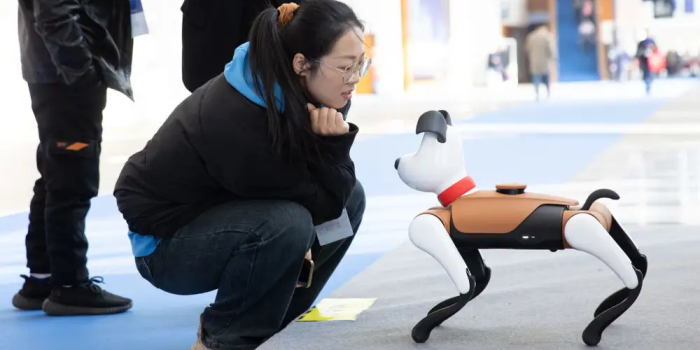In the world of robotics, Boston Dynamics’ dog-like creations have evoked a range of reactions, from awe to an unsettling fear of impending doom. The Museum of Science in Boston houses one of these remarkable machines, a 2016-era “Spot” robot capable of climbing stairs and moving forward and backward yet causing distress to onlookers. Now, a Chinese robotics company, Weilan, introduces a new model, “BabyAlpha,” promising a more endearing and less menacing robot dog experience.
Weilan, showcasing its latest creation at an electronics trade show in Nanjing, Jiangsu Province of China, has taken a step toward making robot dogs more relatable. The “BabyAlpha” is an upgraded version of their previous “AlphaDog” robot, featuring a seemingly simple but impactful addition – ears. This small modification aims to bridge the gap between futuristic technology and human comfort, offering the otherwise uncanny robot dogs a touch of familiarity.

The previous generation, “AlphaDog,” released in 2020, laid the groundwork for the development of “BabyAlpha.” Weilan’s strategic move to incorporate ears into the design acknowledges the importance of human-like features in making these machines less intimidating and more approachable. The subtle addition of this anatomical element helps dispel the eerie aura associated with robot dogs, creating a perception that is closer to a companion than a potential threat.

The absence of information regarding pricing and sales on Weilan’s website leaves potential buyers in suspense, particularly during the holiday season. While the company’s email is down, the unveiling of “BabyAlpha” sparks curiosity among robotics enthusiasts and potential consumers about the future trajectory of robotic companionship.
In the quest for harmonizing technology with human acceptance, Weilan’s “BabyAlpha” emerges as a notable attempt to infuse a sense of warmth and familiarity into the realm of robot dogs. This small but significant step reflects the ongoing evolution of robotics technology, where the inclusion of seemingly trivial details like ears can profoundly impact how we perceive and interact with these artificial beings.


